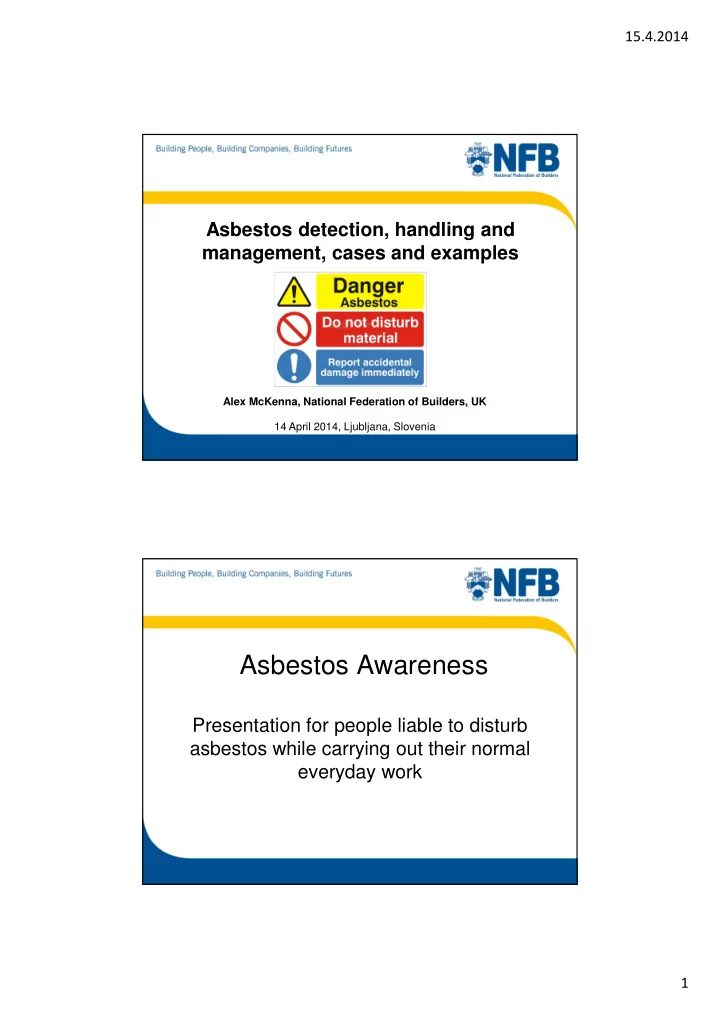

15.4.2014 Asbestos detection, handling and management, cases and examples Alex McKenna, National Federation of Builders, UK 14 April 2014, Ljubljana, Slovenia Asbestos Awareness Presentation for people liable to disturb asbestos while carrying out their normal everyday work 1
15.4.2014 Situation in the UK • The United Kingdom possesses the second highest rate of mesothelioma incidence in the world after the USA • 2,291 deaths in 2011 (latest HSE statistics) • Men who worked in the building industry when asbestos was used extensively are now among those most at risk of mesothelioma 2
15.4.2014 UK mesothelioma deaths • Government-backed compensation scheme for victims established under the Mesothelioma Act in January 2014 Source: HSE Health Risks: Summary The risk of disease is determined by: • The concentration of fibres people are exposed to • The time and frequency over which they are exposed • It can take years from the initial exposure to asbestos fibres for diseases to develop • The diseases cause breathing difficulties and can result in death • Smoking multiplies the risk of developing lung cancer in people exposed to asbestos fibres 3
15.4.2014 Asbestos Locations Asbestos lagging on pipe Loose asbestos used as loft insulation Brown asbestos lagging on in poor condition on steam pipe Source: HSE Asbestos Locations Asbestos insulation board 4
15.4.2014 Asbestos Locations � Asbestos papers, felts and cardboard � Asbestos textiles � Asbestos gaskets, washers and strings � Asbestos cement sheets/tiles for roofing and cladding � Moulded asbestos cement products � Decorative textured coatings � Flooring products — PVC or vinyl tiles � Asbestos reinforced plastic/resin composites � Bitumen products � Friction products Asbestos Locations Asbestos rope seal on a Asbestos textiles drying oven 5
15.4.2014 Asbestos Locations Asbestos cement Asbestos cement roof and wall cladding Asbestos Locations • Metal asbestos composites • Wall jointing tapes and fillers • Domestic appliances and products • Industrial sites, factories and plant • Some machinery may incorporate asbestos — clutches, brake pads, drive belts and conveyor belts • Power stations, chemical plants, factories and warehouses may contain substantial amounts of asbestos 6
15.4.2014 Preventing asbestos fibre release Preventing exposure to asbestos fibres: • do not assume there is no asbestos before work is started • check the asbestos register in a building to identify if asbestos is present before working on any materials • if asbestos is in the material to be disturbed, work should not begin • if in doubt, check first 7
15.4.2014 Emergency Procedure If asbestos materials are disturbed or release of fibres is suspected: • Work should be stopped immediately • The area should be evacuated • Any contaminated clothing should be removed and bagged as close as possible to the contamination source • People should be prevented from entering the area and it should be secured • Contact the supervisor • It should be confirmed if asbestos fibres are present • The area should be vacated until it has been deemed safe to re-enter 8
15.4.2014 Summary • Asbestos is the biggest single cause of occupational disease: it kills around 4,000 people per year • Asbestos cannot be simply identified by the naked eye • Building infrastructure and maintenance workers are most at risk of exposure to asbestos • The main diseases can kill or severally restrict breathing • It can take many years after the initial exposure before symptoms develop • If in doubt, do not start work Questions Get in touch! Alex McKenna, National Federation of Builders Email: Alex.McKenna@builders.org.uk 9
Recommend
More recommend